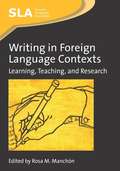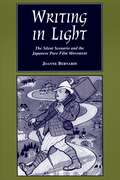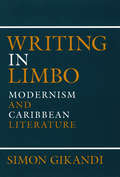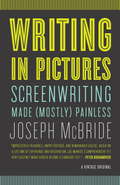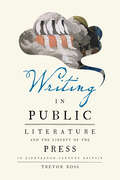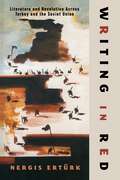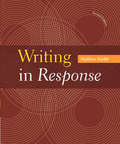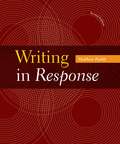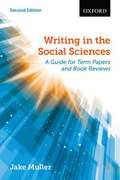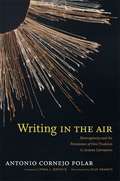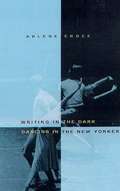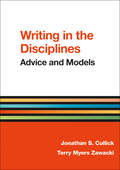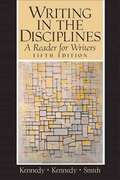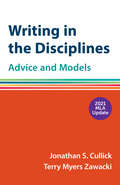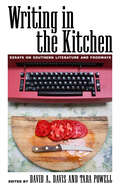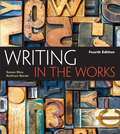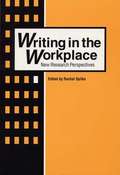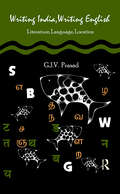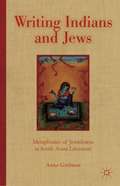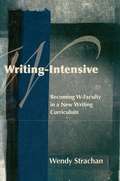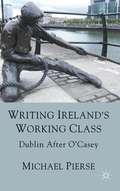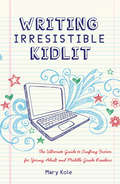- Table View
- List View
Writing in Foreign Language Contexts
by Rosa ManchonThis book represents the most comprehensive account to date of foreign language (FL) writing. Its basic aim is to reflect critically on where the field is now and where it needs need to go next in the exploration of FL writing at the levels of theory, research, and pedagogy, hence the two parts of the book: 'Looking back' and 'Looking ahead'. The chapters in Part I offer accounts of both the inquiry process followed and the main insights gained in various long-term research programs. The chapters in Part 2 contribute a retrospective analysis of the available empirical research and of professional experiences in an attempt to move forward. The book invites the reader to step back and rethink seemingly well established knowledge about L2 writing in light of what is known about writing in FL contexts.
Writing in General and the Short Story in Particular
by L. Rust HillsHere is a practical guide to writing short stories that explains all the essential techniques of fiction - from character and plot to flashback and foreshadowing - in a way that is both understandable and useful to the beginning writer. Long considered a classic in the field, WRITING IN GENERAL is the product of a lifetime of reflection by one of our best literary minds.
Writing in Light: The Silent Scenario and the Japanese Pure Film Movement
by Joanne BernardiWhile most people associate Japanese film with modern directors like Akira Kurosawa, Japan's cinema has a rich tradition going back to the silent era. Japan's "pure film movement" of the 1910s is widely held to mark the birth of film theory as we know it and is a touchstone for historians of early cinema. Yet this work has been difficult to access because so few prints have been preserved. Joanne Bernardi offers the first book-length study of this important era, recovering a body of lost film and establishing its significance in the development of Japanese cinema. Building on a wealth of original-language sources--much of it translated here for the first time--she examines how the movement challenged the industry's dependence on pre-existing stage repertories, preference for lecturers of intertitles, and the use of female impersonators. Bernardi provides in-depth analysis of key scripts--The Glory of Life, A Father's Tears, Amateur Club, and The Lust of the White Serpent--and includes translations in an appendix. These films offer case studies for understanding the craft of screenwriting during the silent era and shed light on such issues as genre, authorship and control, and gender representation. Writing in Light helps fill important gaps in the history of Japanese silent cinema. By identifying points at which "pure film" discourse merges with changing international trends and attitudes toward film, it offers an important resource for film, literary, and cultural historians.
Writing in Limbo: Modernism and Caribbean Literature
by Simon GikandiIn Simon Gikandi’s view, Caribbean literature and postcolonial literature more generally negotiate an uneasy relationship with the concepts of modernism and modernity—a relationship in which the Caribbean writer, unable to escape a history encoded by Europe, accepts the challenge of rewriting it. Drawing on contemporary deconstructionist theory, Gikandi looks at how such Caribbean writers as George Lamming, Samuel Selvon, Alejo Carpentier, C. L. R. James, Paule Marshall, Merle Hodge, Zee Edgell, and Michelle Cliff have attempted to confront European modernism.
Writing in Pictures
by Joseph McbrideWriting in Pictures is a refreshingly practical and entertaining guide to screenwriting that provides what is lacking in most such books: a clear, step-by-step demonstration of how to write a screenplay.Seasoned screenwriter and writing teacher Joseph McBride breaks down the process into a series of easy, approachable tasks, focusing on literary adaptation as the best way to learn the basics and avoiding the usual formulaic approach. With its wealth of useful tips, along with colorful insights from master screenwriters past and present, this book is invaluable for anyone who wants to learn the craft of screen storytelling.
Writing in Public: Literature and the Liberty of the Press in Eighteenth-Century Britain
by Trevor RossWhat is the role of literary writing in democratic society?Building upon his previous work on the emergence of "literature," Trevor Ross offers a history of how the public function of literature changed as a result of developing press freedoms during the period from 1760 to 1810. Writing in Public examines the laws of copyright, defamation, and seditious libel to show what happened to literary writing once certain forms of discourse came to be perceived as public and entitled to freedom from state or private control. Ross argues that—with liberty of expression becoming entrenched as a national value—the legal constraints on speech had to be reconceived, becoming less a set of prohibitions on its content than an arrangement for managing the public sphere. The public was free to speak on any subject, but its speech, jurists believed, had to follow certain ground rules, as formalized in laws aimed at limiting private ownership of culturally significant works, maintaining civility in public discourse, and safeguarding public deliberation from the coercions of propaganda. For speech to be truly free, however, there had to be an enabling exception to the rules. Since the late eighteenth century, Ross suggests, the role of this exception has been performed by the idea of literature. Literature is valued as the form of expression that, in allowing us to say anything and in any form, attests to our liberty. Yet, paradoxically, it is only by occupying no definable place within the public sphere that literature can remain as indeterminate as the public whose self-reinvention it serves.
Writing in Red: Literature and Revolution Across Turkey and the Soviet Union (Modernist Latitudes)
by Nergis ErtürkThe republic of Turkey and the Soviet Union both emerged from the wreckage of empires surrounding World War I, and pathways of literary exchange soon opened between the two revolutionary states. Even as the Turkish government pursued a friendly relationship with the USSR, it began to persecute communist writers. Whether going through official channels or fleeing repression, many Turkish writers traveled to the Soviet Union during the 1920s and 1930s, publishing original work, editing prominent literary journals, and translating both Russian classics and Soviet literature into Turkish.Writing in Red traces the literary and exilic itineraries of Turkish communist and former communist writers, examining revolutionary aesthetics and politics across Turkey and the Soviet Union from the mid-1920s through the 1960s. Nergis Ertürk considers a wide range of texts—spanning genres such as erotic comedy, historical fiction and film, and socialist realist novels and theater—by writers including Nâzim Hikmet, Vâlâ Nureddin, Nizamettin Nazif, Suat Derviş, and Abidin Dino. She argues that these works belong simultaneously to modern Turkish literature, a transnational Soviet republic of letters, and the global literary archive of world revolution, alongside those of other writers who made the “magic pilgrimage” to Moscow. Exploring how Turkish communist writers on the run produced a remarkable transnational literature of dissent, Writing in Red offers a new account of global revolutionary literary culture.
Writing in Response
by Matthew ParfittWriting in Response is a flexible, brief rhetoric that offers a unique focus on the critical practices of experienced readers, analysis and reflection, the skills at the heart of academic writing. It helps students compose academic essays by showing how active reading and exploratory writing bring fresh ideas to light and how informal response is developed into polished, documented prose. Extensively class tested, Writing in Response emphasizes the key techniques common to reading, thinking, and writing throughout the humanities and social sciences by teaching students the value of a social, incremental, and recursive writing process. The new edition includes more on working with digital tools, more help for writing, and updated readings.
Writing in Response
by Matthew ParfittWriting in Response is a flexible, brief rhetoric that offers a unique focus on the critical practices of experienced readers--analysis and reflection--the skills at the heart of academic writing. It helps students compose academic essays by showing how active reading and exploratory writing bring fresh ideas to light and how informal response is developed into polished, documented prose. Extensively class tested,Writing in Response emphasizes the key techniques common to reading, thinking, and writing throughout the humanities and social sciences by teaching students the value of a social, incremental, and recursive writing process.
Writing in Response (Second Edition)
by Matthew ParfittWriting in Response is a flexible, brief rhetoric that offers a unique focus on the critical practices of experienced readers, analysis and reflection, the skills at the heart of academic writing. It helps students compose academic essays by showing how active reading and exploratory writing bring fresh ideas to light and how informal response is developed into polished, documented prose. Extensively class tested, Writing in Response emphasizes the key techniques common to reading, thinking, and writing throughout the humanities and social sciences by teaching students the value of a social, incremental, and recursive writing process. The new edition includes more on working with digital tools, more help for writing, and updated readings.
Writing In The Social Sciences: A Guide For Term Papers And Book Reviews
by Jake MullerIdeal for students new to academic writing, Writing in the Social Sciences, Second Edition, is a clear, step-by-step guide to the entire writing process. Students will learn how to select and research a topic, develop and refine their ideas into a comprehensive outline, and convert the outline into a research paper or book report.
Writing in the Air: Heterogeneity and the Persistence of Oral Tradition in Andean Literatures
by Polar Antonio Cornejo Jentsch Lynda J.Originally published in 1994, Writing in the Air is one of the most significant books of modern Latin American literary and cultural criticism. In this seminal work, the influential Latin American literary critic Antonio Cornejo Polar offers the most extended articulation of his efforts to displace notions of hybridity or "mestizaje" dominant in Latin American cultural studies with the concept of heterogeneity: the persistent interaction of cultural difference that cannot be resolved in synthesis. He reexamines encounters between Spanish and indigenous Andean cultural systems in the New World from the Conquest into the 1980s. Through innovative readings of narratives of conquest and liberation, homogenizing nineteenth- and twentieth-century discourses, and contemporary Andean literature, he rejects the dominance of the written word over oral literature. Cornejo Polar decenters literature as the primary marker of Latin American cultural identity, emphasizing instead the interlacing of multiple narratives that generates the heterogeneity of contemporary Latin American culture.
Writing in the Dark, Dancing in the New Yorker
by Arlene CroceArlene Croce was The New Yorker's dance critic, a post created for her. Her entertaining, forthright, passionate reviews have revealed the logic and history of ballet, modern dance, and their postmodern variants to a generation of theatergoers.
Writing in the Disciplines: Advice and Models
by Jonathan S. Cullick Terry Myers ZawackiWith practical advice and plenty of student models, Writing in the Disciplines provides a jump start for writing college papers in nine disciplines -- biology, business, criminal justice/criminology, education, engineering, history, music, nursing, and psychology. Each discipline section features information on audience expectations in that area of study, the types of questions asked, the types of documents produced, the kinds of evidence used, appropriate language conventions, and appropriate citation styles. Each section features a model student paper (two in business) written in response to a typical assignment in the discipline.
Writing in the Disciplines: A Reader for Writers
by William J. Kennedy Mary Lynch Kennedy Hadley M. SmithThis combination rhetoric/anthology shows readers how to read academic volumes effectively and how to use them as sources for papers in a variety of disciplines. Throughout, readers learn how to work individually and collaboratively as they move through the entire process of writing from sources?from reading the original source to planning, drafting and revising essays. The rhetoric section teaches readers the fundamental strategies for all phases of academic writing?critical reading, paraphrasing, summarizing, quoting, organizing, drafting, revising, editing, synthesizing, analyzing, researching, and developing arguments. The anthology section offers engaging reading selections that introduce readers to the issues and the methods of study in the sciences, social sciences, and humanities, and that serve as idea banks for their writing assignments. For individuals interested in a comprehensive treatment of academic writing.
Writing in the Disciplines with 2021 MLA Update: A Hacker Handbooks Supplement
by Diana Hacker Nancy Sommers Jonathan S. Cullick Terry Myers ZawackiThis ebook has been updated to provide you with the latest guidance on documenting sources in MLA style and follows the guidelines set forth in the MLA Handbook, 9th edition (April 2021).With practical advice and plenty of student models, Writing in the Disciplines provides a jump start for writing college papers in nine disciplines — biology, business, criminal justice/criminology, education, engineering, history, music, nursing, and psychology. Each discipline section features information on audience expectations in that area of study, the types of questions asked, the types of documents produced, the kinds of evidence used, appropriate language conventions, and appropriate citation styles. Each section features a model student paper (two in business) written in response to a typical assignment in the discipline. Advice for writing in business, criminal justice, education, nursing, and psychology includes updated APA guidelines (2020).
Writing in the Environmental Sciences: A Seven-Step Guide
by Baker L. MichelleAs an environmental scientist, you are used to writing scientific articles, but how confident do you feel writing policy or regulatory documents? Do you feel you have the necessary writing skills to influence policy and inform the public? This refreshingly clear guide provides environmental scientists and conservation professionals with an effective writing process that can be applied in a range of financial, political, or organizational contexts. Baker outlines a replicable seven-step writing formula based on practical experience that acknowledges the complexities inherent in the worlds of endangered species, habitat conservation, and recovery planning. Using the formula, scientists will be able to communicate confidently and successfully with a multitude of audiences. Baker's guide is written for scientists, not professional writers. In it, best practices abound. Practical examples, strategies, and diagrams guide the reader at every step, and selected resources are provided for further reference.
Writing in the Kitchen: Essays on Southern Literature and Foodways
by Clayton BrumbyScarlett O'Hara munched on a radish and vowed never to go hungry again. Vardaman Bundren ate bananas in Faulkner's Jefferson, and the Invisible Man dined on a sweet potato in Harlem. Although food and stories may be two of the most prominent cultural products associated with the South, the connections between them have not been thoroughly explored until now. Southern food has become the subject of increasingly self-conscious intellectual consideration. The Southern Foodways Alliance, the Southern Food and Beverage Museum, food-themed issues of Oxford American and Southern Cultures, and a spate of new scholarly and popular books demonstrate this interest. Writing in the Kitchen explores the relationship between food and literature and makes a major contribution to the study of both southern literature and of southern foodways and culture more widely. This collection examines food writing in a range of literary expressions, including cookbooks, agricultural journals, novels, stories, and poems. Contributors interpret how authors use food to explore the changing South, considering the ways race, ethnicity, class, gender, and region affect how and what people eat. They describe foods from specific southern places such as New Orleans and Appalachia, engage both the historical and contemporary South, and study the food traditions of ethnicities as they manifest through the written word.
Writing in the Works (Fourth Edition)
by Susan Blau Kathryn BurakIn this fourth edition, the authors focus on writing as both an academic and practical tool, and updated the content and spirit of the book to prepare you to thrive in the contemporary writing environment. You will learn to write for the digital world--where visual and verbal messages are inseparable--and do so by exploring ideas that will engage the real-world audiences you will encounter long after your college years. Equipped with the skills you will learn for many writing applications--including analyses for college courses, reports and proposals for work, blogs and editorials, podcasts, infographics, and more--you will be prepared to ride the global communication wave as a more confident, capable writer.
Writing in The Workplace: New Research Perspectives
by Rachel SpilkaRachel Spilka brings together nineteen previously unpublished essays concerned with ways in which recent research on workplace writing can contribute to the future direction of the discipline of technical and professional writing. Hers is the first anthology on the social perspective in professional writing to feature focused discussions of research advances and future research directions. The workplace as defined by this volume is a widely diverse area that encompasses small companies and large corporations, public agencies and private firms, and a varied population of writersengineers, managers, nurses, social workers, government employees, and others. Because much research has been conducted on the relationship between workplace writing and social contexts since the ground breaking 1985 publication of Odell and Goswami s "Writing in Nonacademic Settings, "Spilka contends that this is an appropriate time for the professional writing community to consider what it has learned to date and where it should be heading next in light of these recent discoveries. She argues that now professional writers should try to ask better questions and to define new directions. Spilka breaks the anthology into two parts. Part 1 is a collection of ten essays presenting textual and qualitative studies conducted by the authors in the late l980s on workplace writing. Spilka has chosen these studies as representative of the finest research being conducted in professional writing that can serve as models for current and future researchers in the field. Barbara Couture, Jone Rymer, and Barbara Mirel report on surveys they conducted relying on the social perspective both to design survey instruments and to analyze survey data. Jamie MacKinnon assesses a qualitative study describing what workplace professionals might need to learn about social contexts and workplace writing. Susan Kleimann and editor Rachel Spilka discuss multiple case studies they conducted that help explain the value during the composing process of social interaction among the participants of a rhetorical situation. Judy Z. Segal explores the negotiation between the character of Western medicine and the nature of its professional discourse. Jennie Dautermann describes a qualitative study in which a group of nurses "claimed the authority to restructure their own procedural information system. " Anthony Parefinds in a case study of social workers that writing can be constrained heavily by socially imposed limitations and restrictions. Graham Smart describes a study of discourse conventions in a financial institution. Geoffrey A. Cross reports on a case study of the interrelation of genre, context, and process in the group production of an executive letter and report. Part 2 includes nine essays that assess the implications of recent research on workplace writing on theory, pedagogy and practice, and future research directions. Mary Beth Debs considers research implications for the notion of authorship. Jack Selzer explores the idea of intertextuality. Leslie A. Olson reviews the literature central to the concept of a discourse community. James A. Reither suggests that writing-as-collaboration in the classroom focuses "more on the production of texts to be evaluated than on ways in which texts arise out of other texts. " Rachel Spilka continues Reither s discussion of how writing pedagogy in academia might be revised with regard to the social perspective. Patricia Sullivan and James E. Porter respond to the debate about the authority of theory versus that of practice on researchers notions of methodology. Mary Beth Debs considers which methods used in fields related to writing hold promise for research in workplace writing. Stephen Doheny-Farina discusses how some writing researchers are questioning the underlying assumptions of traditional ethnography. Finally, Tyler Bouldin and Lee Odell suggest future directions for the research of workplace writing. "
Writing India, Writing English: Literature, Language, Location
by G. J. PrasadThe essays in this book look at the interaction between English and other Indian languages and focus on the pressure of languages on writers and on each other. Divided into two parts, the first part of the book deals with the pressure that English language has exerted, and continues to exert, in India and our ideas of connectedness as a nation in the ways in which we deal with this pressure. The essays emphasise on the emergence of the hybrid language in the Tamil cultural world because of the presence of English (and Hindi); on the politics of ‘anthologisation’; and how Karnad’s Tughlaq deals with the idea of the nation, looking at its historical location. The second part of the book focuses on Indian English literature and deals with how it interacts with the idea of representing the Indian nation, sometimes obsessively, seen both in poetry and novels. The book argues that the writer’s location is crucial to the world of imagination, whether in the novel, poetry or drama. The world is inflected by the location of the author, and the struggle between the language dominant in that location and English is part of the creative tension that provides energy and uniqueness to writing.
Writing Indians and Jews
by Anna GuttmanWriting Indians and Jews examines discursive practices surrounding the representation of Jews and Jewishness in Indian literature in English. These investigations make an important contribution to the study of contemporary South Asian and diasporic literature, and understandings of anti-Semitism, religious fundamentalism, and globalization.
Writing-Intensive: Becoming W-Faculty in a New Writing Curriculum
by Wendy StrachanIn one of the few book-length studies of a major post-secondary writing-across-the-curriculum initiative from concept to implementation, Writing-Intensive traces the process of preparation for new writing requirements across the undergraduate curriculum at Simon Fraser University, a mid-sized Canadian research university. As faculty members across campus were selected to pilot writing-intensive courses, and as administrators and committees adjusted the process toward full implementation, planners grounded their pedagogy in genre theory—a new approach for many non-composition faculty. So doing, the initiative aimed to establish a coherent yet rhetorically flexible framework through which students might improve their writing in all disciplines. Wendy Strachan documents this campus cultural transformation, exploring successes and impasses with equal interest. The study identifies factors to be considered to avoid isolating the teaching of writing in writing-intensive courses; to engender a university-wide culture that naturalizes writing as a vital part of learning across all disciplines; and to keep the teaching of writing organic and reflected upon in a scholarly manner across campus. A valuable case history for scholars in writing studies, WAC/WID, and curricular change studies.
Writing Ireland’s Working Class
by Michael PierseExploring writing of working-class Dublin after Se#65533;n O'Casey, this book breaks new ground in Irish Studies, unearthing submerged narratives of class in Irish life. Examining how working-class identity is depicted by authors like Brendan Behan and Roddy Doyle, it discusses how this hidden, urban Ireland has appeared in the country's literature.
Writing Irresistible Kidlit: The Ultimate Guide to Crafting Fiction for Young Adult and Middle Grade Readers
by Mary KoleCaptivate the hearts and minds of young adult readers! Writing for young adult (YA) and middle grade (MG) audiences isn't just "kid's stuff" anymore--it's kidlit! The YA and MG book markets are healthier and more robust than ever, and that means the competition is fiercer, too. In Writing Irresistible Kidlit, literary agent Mary Kole shares her expertise on writing novels for young adult and middle grade readers and teaches you how to: Recognize the differences between middle grade and young adult audiences and how it impacts your writing. Tailor your manuscript's tone, length, and content to your readership. Avoid common mistakes and cliches that are prevalent in YA and MG fiction, in respect to characters, story ideas, plot structure and more. Develop themes and ideas in your novel that will strike emotional chords. Mary Kole's candid commentary and insightful observations, as well as a collection of book excerpts and personal insights from bestselling authors and editors who specialize in the children's book market, are invaluable tools for your kidlit career. If you want the skills, techniques, and know-how you need to craft memorable stories for teens and tweens, Writing Irresistible Kidlit can give them to you.
